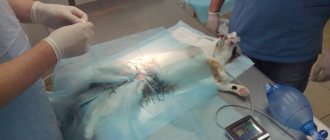The difference between castration and sterilization
Conventional wisdom associates spaying and neutering with the sex of a pet, but these are different types of surgery. Sterilization only prevents conception; after castration, sexual desire ceases. Both operations are performed on both males and females.
Sterilization of cats and female cats is possible; The only difference between sterilization of a cat and a cat is that the fallopian tubes are ligated in females, and the seminal ducts in males. The reproductive organs will be preserved, the instincts will remain, only the ability to reproduce is lost.
Castration is the removal of genital organs: the ovaries and uterus are cut out from cats, and cats are deprived of testicles. This method not only blocks the ability to reproduce, but also changes the behavior of animals.
Differences between operations: how are they expressed?
Castration, or scientifically, ovariohysterectomy, means surgical intervention to remove organs of the reproductive system. That is, the testicles are cut out from males, and the ovaries and uterus from females. A less common operation is called an oophorectomy, in which only the cat's ovaries are removed. But this practice is gradually being abandoned, since complications often occur in the form of pathological diseases such as testicular or uterine cancer.
After going through this procedure, the animal gradually calms down and stops behaving aggressively.
A castrated cat gets rid of the following negative character traits:
- aggressiveness;
- high excitability;
- dominance.
During sterilization (vasectomy), the surgeon creates a barrier inside the body that prevents the movement of cells needed to conceive a fetus. Then the female cats have their tubes tied, and the cats have their spermatic cords tied. In this case, the doctor does not touch the reproductive system. Therefore, after the procedure, the animal’s character and its instincts do not change: pets still feel the need to mate, but pregnancy does not occur. But due to the fact that the organs continue to function as before, the production of hormones does not stop. Therefore, pets after a vasectomy are more susceptible to attacks of aggression, stress and excitability. It was found that animals that were sterilized are more susceptible to cancer and inflammatory diseases of the reproductive and genitourinary systems.
How does castration work?
In a castrated cat, the uterus and ovaries are removed through a deep incision, and stitches are placed on the wound. Depending on the location of the operating area and the instruments used, the following castration methods are distinguished: median (the skin is cut in the center of the abdomen by 1-3 cm), through a lateral incision (the uterus is removed through an incision on the side), laparoscopic method (a puncture in the peritoneum, using special equipment ).
The skin of the scrotum of a castrated male is cut, the testis is removed and removed, and the spermatic cord is ligated. With pathology (cryptorchidism), the ovary is located in the groin area, and not in the scrotum, which complicates the operation. In addition to the classic open method, there is bloodless castration: the spermatic cords are crushed with forceps.
How is castration of a male cat carried out?
Before starting the intervention, disinfection of the surgical field is necessary.
This method is painless for cats. Before the operation begins, the veterinarian administers anesthesia medications. Afterwards, the cat’s hair near the scrotum is shaved and this area of skin is disinfected. The surgery itself lasts 10 minutes. During this time, doctors remove organs and apply stitches. For cats, the procedure is more complicated. They make an incision in the groin area. Through it, the ovaries and uterus are removed, then stitches are placed. The whole process takes place in 40 minutes. After surgery, cats are put on a special collar that prevents licking and scratching the wounds.
How does sterilization occur?
Castration of a cat differs from sterilization by a lower risk of complications, which is why it has become more often used among owners of these animals. Sterilization involves ligating the female's fallopian tubes, which prevents the egg from entering the uterus. After the procedure, the risks of inflammatory diseases of the reproductive system increase. When a male is sterilized, the spermatic ducts are ligated, which blocks the release of sperm.
After the operation, the ability to reproduce is lost, but hormonal release does not decrease, and libido remains. If the owner is bothered by the sexual instincts of a four-legged pet, then sterilization will not solve the problem: the animal’s behavior will practically not change.
Pros and cons of different surgical interventions
Castration
Often, animals that undergo the procedure begin to recover.
It is believed that a pet after such an operation lives 2-3 years longer, in contrast to an uncastrated cat. The pet becomes affectionate, calm, and stays at home more. He does not show interest in individuals of the opposite sex. Castration has a positive effect on health: in cats, the risk of developing cancer of the uterus and mammary glands is reduced. But due to decreased activity, many animals gain weight. This leads to the occurrence of diseases of the diuretic system.
Sterilization
Ovariohysterectomy is considered a less humane procedure than vasectomy.
After the operation, all organs continue to function fully, so the animal sometimes experiences hormonal surges. Because of this, pets experience severe stress, become aggressive, and lose weight. After sterilization, the risk of cancer and inflammatory processes increases. This method is used by cat owners who strive to preserve the instincts of their pet. But doctors still prefer castration to stop the reproductive functions of cats.
Preparing for surgery
Despite the difference between sterilization and castration operations, the preparation measures for the procedure are no different:
- Vaccination. Vaccinations against infectious diseases are given 2-4 weeks before surgery. If the operation is performed in a clinic, the risk of infection from someone else's animal is minimized. At home, vaccine-enhanced immunity will help avoid possible complications due to incomplete sterility. If the procedure needs to be done urgently, hyperimmune serum is injected.
- Preliminary inspection. The operation will reduce immunity, so the cat should not have any ailments. It is also advisable to carry out antiparasitic treatment.
- Mandatory food restriction. Anesthetic drugs may cause vomiting. 12 hours before the expected time of surgery, you should not feed your pet, and 2-3 hours before the procedure, even water should be excluded from the diet.
Pros and cons of castration
What is good about sterilization and what is bad about it, we found out above. Now let's move on to castration.
Benefits of castration:
- Reproductive organs are removed. The cat stops demanding the cat, tormenting the entire family and neighbors with screams. The cat is not interested in “girlfriends”. Consequently, he does not try to run away from home and does not throw concerts.
- Neutered pets live several years longer. There is an opinion that after castration the animal gets fat. If fed correctly, a male cat will not turn into a bun.
Flaws:
- What is the difference between castration and sterilization of cats? Because it is performed under anesthesia. This is a heavy load on the body. After the procedure, the owner must carefully monitor the pet. The animal moves as if in slow motion and does not think well. He will jump onto a high cabinet, fail to calculate his strength and fall. This cannot be allowed.
- An older pet should not be neutered. The heart may not withstand anesthesia.
So, spaying or neutering a cat: what is the difference? We see that it is better to castrate a pet than to sterilize it. In the first case, the animal loses its reproductive organs. In the second, she simply will not be able to have kittens.
Postoperative care
Care after sterilization depends on the sex of the animal. In females, abdominal surgery is performed, stitches are applied, and the body recovers for 2-3 days. In males, the wound is shallow and heals faster; health returns to normal the very next day.
Care stages:
- Place in a safe, warm place. Under anesthesia, thermoregulation is disrupted, and the cat needs additional warmth. Coordination of movements is temporarily impaired: it is necessary to protect the animal from injury when it wakes up and tries to get up.
- Lay down a waterproof bedding or absorbent diaper: when recovering from anesthesia, involuntary urination is possible.
- Take care of your eyes. Cats under anesthesia do not close their eyes. To avoid postoperative conjunctivitis, you need to periodically instill saline into the eyes or close the animal’s eyelids every 5-10 minutes.
- Do not feed during recovery from anesthesia. Due to a violation of the swallowing reflex, only water can be given to a cat for the first 12 hours, to a cat for 24 hours.
- Protect stitches or wound. The male does not require special care for the wound; in case of scratching, a special collar can be worn. The female should wear a blanket or bandage for 7-10 days until the stitches are removed and 1-2 days until the final healing. If the wound becomes wet or festered, the surgical area is treated with an alcohol-free antiseptic. During the first 2-3 days, tissue swelling is allowed.
- Follow the veterinarian's recommendations. The animal may be prescribed additional antibiotics and undergo an additional examination to prevent complications.
Medical indications for cat sterilization
The main reason for sterilizing a cat is to exclude unwanted pregnancy. But there are a number of medical indications for such an operation:
- Violation of the sexual cycle: estrus occurs once every 1-2 months or more often; prolongation of the estrus period itself;
- Diagnosed pathologies of the reproductive system: purulent endometritis (pyometra), cysts or neoplasms of the ovaries and uterus.
At what age is surgery recommended?
It is better to do the operation before the pet reaches puberty. For cats, the optimal age is 7-9 months (preferably before the first mating), for a cat - 6-7 months (before the onset of estrus). The differences between castration and sterilization of cats do not affect the age permissible for surgery; You only need to take into account how strong the animal’s body is.
If the procedure is carried out earlier than the recommended age, the kitten owner may encounter problems with the animal's growth and development being delayed. Operational risks will also increase, since the kitten is not yet fully formed. If the operation is performed later, the risk of complications increases in proportion to the age of the animal. The older the animal, the harder the anesthesia is tolerated, the longer the recovery, and the higher the likelihood of postoperative complications.
If the pet is over 7 years old, then the doctor can play it safe: prescribe preliminary tests, conduct a heart examination.
For females there are additional indications. It is better to carry out the operation before the first birth, when sex hormones are produced only by the ovaries, and not by other endocrine glands. It is not recommended to carry out the procedure during estrus: the internal genital organs become filled with blood, which will complicate the operation. If the cat has already given birth, then it is better to postpone the operation for 2-3 weeks after stopping feeding the kittens. During pregnancy, hysterectomy is recommended only for medical reasons, as changes in hormonal levels and physiology will complicate the operation.
What is castration and sterilization
Since cat owners often have questions about whether to spay or neuter their cat, they should know what both involve. Castration is a veterinary operation to completely remove the genital organs of animals, including female cats. There are 2 types of castration:
- oophorectomy or removal of the ovaries;
- ovariohysterectomy or removal of the ovaries along with the uterus.
Typically, healthy young cats that have not yet given birth have their ovaries removed alone, but in some cases, to avoid the development of feline gynecological problems, the uterus is also removed . But even if only the ovaries are removed, estrus is interrupted in castrated cats due to the cessation of egg production. As a result, all symptoms of sexual behavior, including annoying cat “songs,” also end.
When sterilizing cats, the fallopian tubes are simply tied, without partial or complete removal of the internal genital organs.
The ovaries and uterus remain, work normally and continue to produce hormones. Therefore, sterilized individuals retain normal sexual desire and all instincts, they retain the ability to mate, but with 100% probability they cannot bear offspring, since they become completely sterile. This is precisely the difference between castration and sterilization.
© shutterstock
Pros and cons of the procedure, opinion of veterinarians
Positive effects of castration and sterilization:
- The production of sex hormones decreases. Animals do not run away in search of partners and do not mark their territory.
- Aggression decreases. The pet becomes calm and balanced.
- The risk of cancer becomes lower.
- Certain diseases are prevented. Castration reduces the risk of neoplasms, inflammation of the uterus, prostatitis and other diseases of the reproductive system.
- Fertility is blocked. The cat loses the ability to reproduce. Cats stop reacting to the opposite sex.
- Behavioral problems disappear. The animal becomes docile and obedient. A castrated cat does not mark territory and does not conflict with other males.
- Life expectancy increases. Neutered animals live on average 1.5-2 years longer.
Negative aspects of the operation:
- Operational risks. Complications after anesthesia and surgery, decreased immunity, and long recovery of the body are possible.
- Hormonal imbalance. Neutered cats have a slower metabolism. An incorrect diet for a pet after surgery will lead to obesity and physical inactivity.
- Increased risk of inflammatory processes in the uterus during sterilization of cats and the development of urolithiasis for neutered cats.
- Preservation of instincts after sterilization. If the reproductive organs are not completely removed, then the animals retain normal sexual reactions: they continue to mate, mark their territory, and behave aggressively.
Sterilization of cats - pros and cons
There are opponents to sterilizing cats. It is not difficult to understand their point of view. Defenders of the natural development of animals want to give every pet healthy offspring. However, at home, giving birth to a cat can be a very painful sight - both for the animal itself and for its owners.
The main disadvantage of sterilizing cats is that the sterilized animal becomes prone to obesity. However, obesity is easily preventable through a well-balanced diet.
Sterilization of cats has a great advantage - it is an opportunity to significantly increase the length and quality of life of the animal. In their natural environment, cats give birth two or more times a year. As a result, their body wears out greatly, and they live no more than 7 years. Unsterilized domestic cats live a little longer. Even if they kitted only 1-2 times in their lives, their life expectancy is 10-12 years. However, it is not uncommon that after 7 years of age they develop various pathologies of the genital organs due to excess hormones.
Animals that undergo sterilization (i.e., removal of the genital organs) are freed from the risk of developing inflammation of the reproductive organs for life. The logic is clear. No organs - no problems. The average life expectancy of sterilized animals is 15 years. Centenarians reach the age of 20 years or more.
Possible complications
- Consequences of anesthesia. If the animal has no appetite for more than 3 days, weakness and lethargy are observed, you should consult a doctor. Due to reduced immunity after surgery, chronic and indolent diseases may worsen.
- Wound infection. If the swelling does not subside for more than 3 days, the surgical area is red, there is purulent discharge - this is also a reason to return to the clinic.
- Metabolic disease. Castration differs from sterilization by disrupting hormonal levels, therefore, before choosing to castrate cats, you need to take care of choosing the right diet and reducing the caloric content of food.
If your pet is healthy and properly prepared for the procedure, then there will be virtually no problems. Constant supervision when recovering from anesthesia and following recommendations for care after surgery will reduce possible risks to a minimum.
All information posted on the site is provided in accordance with the User Agreement and is not a direct instruction to action. We strongly recommend that before using any product, you must obtain a face-to-face consultation at an accredited veterinary clinic.
Pros of cat castration
The main advantage of surgery to remove the uterus and ovaries is to stop sexual activity and prevent pregnancy. But there are other positive aspects of this operation:
- Statistically, the life expectancy of castrated cats increases.
- The possibility of developing purulent endometritis, ovarian cysts, and neoplasms of the female reproductive system is prevented;
- Due to the lack of sexual heat, the cat stops meowing for days on end during estrus, thereby trying to attract a male cat. This behavior in domestic cats leads to sleepless nights for owners;
- Behavior is corrected due to the absence of sexual hunting, and there is no need to mark the territory;
- The risk of contracting infectious sexually transmitted diseases is eliminated.











